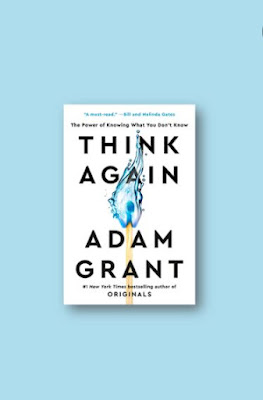A Nuanced Approach to Dismantling Biases and Misconceptions in Adam Grant’s Think Again
In today’s highly polarized society, it has become increasingly common to critique the “other” and simply dismiss their views as outdated, close-minded, or otherwise intolerable. Incessant arguments about a myriad of issues both controversial and insignificant abound on social media platforms, political arenas, the workplace and educational spheres alike, with no real progress or true understanding ever seeming to be made. Moreover, the rapidly-changing nature of the world in the information age means that new knowledge and competing ideas are constantly being developed, with or without individuals consciously realizing it. As an organizational psychologist well versed in interpersonal conflict and aware of the capabilities of the human mind, Adam Grant attempts to reconcile these tensions in his book, Think Again.
As the title would suggest, the piece calls readers to rethink the way in which their brains process information and engage in dialogue and disagreements with others. A key point Grant makes throughout the book is the importance of thinking like a scientist. Too often, individuals cling to their beliefs, without bothering to critically assess them or fully process information that is in contradiction with them. Individuals find themselves stubbornly closing off their minds to new information, or simply spewing their own perspectives at others, failing to truly listen to the other side. Grant challenges readers to instead “test” new ideas as a scientist would, taking in all the necessary knowledge and allowing the brain to truly digest and process it. This requires building an awareness of and surrendering biases that may impede this process. In other words, individuals must motivate themselves to expand their minds and have their intellect sharpened.
Grant makes a number of valid points throughout his book, but those perhaps which are the most compelling and important are related to the dismantling of stereotypes. In chapter six, Grant states that “the most effective way to help people pull the unsteady Jenga blocks out of their stereotype towers is to talk with them in person.” To illustrate this point, Grant tells the story of a black musician named Daryl Davis who encountered and interacted with a member of the KKK. Through patient, and open-ended conversations, Davis was able to support and help the Klansman realize the danger of his beliefs, and the profound prejudice behind them. Eventually, the man left the Klan, and renounced his archaic views altogether. While this story certainly is heartfelt, the more important point Grant tries to make is the importance of dialogue in helping to reshape perspectives. Too often, individuals attempt to change the minds of others through arguments or by shaming those with contrasting beliefs. Davis, Grant points out, did almost the exact opposite, by engaging in dialogue that caused the Klansman to think for himself and critically reflect on his own beliefs. This, says Grant, is how we ought to approach those whose opinions we disagree with. Face-to-face conversations done in this manner have the capacity to make profound impact in a world that is increasingly digitally divided.
At times in Think Again, it may seem as though Grant takes issue with conviction as a whole. Throughout the book one gets the sense that he is calling readers to constantly question and challenge all their beliefs and ideas they take in. However, there is still something to be said for the importance of enduring conviction, which Grant seems to simply brush over in his piece. Perhaps that was not his intent, but for those who hold certain deeply-held moral or religious convictions, Grant’s call to challenge every belief might seem a little insensitive or harsh at times.
Nevertheless, Think Again still serves as a beneficial read for all. Throughout the book Grant offers helpful and insightful advice on how to engage in debates and disagreements in a way that emphasizes the common ground held between individuals first and foremost. More importantly though, the book calls readers to examine the logs in their own eyes and humbly reassess their own beliefs. When approaching disagreements, says Grant, individuals ought to do so in a way that not only pursues personal growth but also seeks collective unity and reconciliation. By no means is his advice always simple to follow, yet nevertheless the book as a whole still serves as a meaningful foundation for improved dialogue and problem solving, especially for those seeking to serve in the public sphere and promote the common good.


I like this post ^^
ReplyDelete